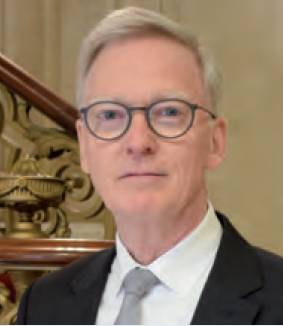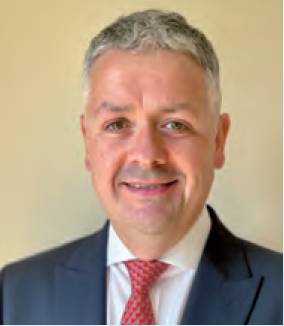Message from RAeS
Message from RAeS
 As a charity and professional body, the Royal Aeronautical Society’s mission is to advance aerospace, aviation and space, promote professional excellence and lifelong learning, and secure its future by encouraging future generations to join our industry.
As a charity and professional body, the Royal Aeronautical Society’s mission is to advance aerospace, aviation and space, promote professional excellence and lifelong learning, and secure its future by encouraging future generations to join our industry.
Our Corporate Partners1, a diverse community of organisations across the entire spectrum of the industry, large and small, are all aligned to the Society’s values, aims and objectives. Most recently, I was kindly invited to visit Marshall Aerospace and Defence Group2, an independent company founded in 1909 and one of our longstanding and highly committed Corporate Partners. Although not able to attend myself, the President-Elect, Peter Round, went on my behalf with our Chief Executive Dave Edwards and were very well received.
Founded 156 years ago, the Society has always been aware of the need for continuous evolution, and today wishes to ensure that it is able to continually engage with and involve a diverse and engaged membership in Society activities.
One specific change is in direct response to the reduction in the size of the Executive Team, a measure stemming from the Covid pandemic. As proposed by the Specialists Group Coordination Committee and approved by the Learned Society Board, to both attract a large audience and to engage a sufficient number of sponsors, and while not excluding other conferences prepared by Specialist Groups themselves, the Executive Team will be asked to concentrate on five major conferences this year.
Two of the five major conferences will be space-related.
The first, planned for the end of April 2022, and entitled ‘Towards a Space-Enabled Net-Zero Earth’ is a follow-up to COP26 and will debate how space-enabled technologies both support the understanding of climate change and allow the UK to take global leadership in achieving carbon-neutral goals by 2050 or earlier.
The second space-related conference, planned for October 2022, will be the 2022 President’s Conference, addressing the important subject of commercial ‘New Space’, and allowing practitioners to share knowledge regarding the capabilities offered by ‘New Space’ and the resulting benefits to society.
On another subject, one tremendous leap in humankind’s quest to understand our Universe and our origins, has been the long-awaited launch on 25 December 2021, of the James Webb Space Telescope (JWST)3, an international collaboration mission between NASA, ESA and the Canadian Space Agency (CSA), designed to examine every phase of cosmic history from the first luminous glows after the Big Bang, on to the formation of galaxies, stars and planets and to the evolution of our own Solar System.
Taken aloft by an ESA Ariane 5 launch vehicle and, unlike the Hubble Space Telescope, the 6,500kg JWST is not in orbit around the Earth but around the Sun4, at a distance of one million miles beyond the Earth at what is called the second Lagrange point (L2), exactly as had been the case for the earlier ESA Herschel Space Telescope and the ESA Planck Space Observatory missions.
This orbit lets JWST stay in proximity with the Earth as it moves around the Sun and allows the large JWST sunshield (69.5ft by 46.5ft) to protect the telescope from the light and heat of the Sun and Earth (and Moon) so it can operate at around minus 225°Celsius, just 50 degrees above absolute zero.
The excellent accuracy of the Ariane 5 launch and orbital insertion also means that very little spacecraft fuel was needed for post-launch orbital corrections, thereby permitting a longer operational life.
NASA’s JWST team at Goddard has already successfully deployed the sunshield and the 21ft gold-coated primary mirror, completing the final stage of all major spacecraft deployments in preparation for science commissioning operations.
As a final note, following the 77th Divisional Council Meeting held on 6 January 2022, I wish to welcome all newly elected members to the Council of the RAeS Pakistan Division, in particular Captain J S M Sadiq FRAeS as President, and Col (Retired) Sayed Mukhtar Asif FRAeS as Vice President. In particular, I would like to sincerely thank AM Salim Arshad FRAeS, for his leadership and dedication during his time as President of the Pakistan Division’s Council over the past ten years and for now taking on his new role as Past President.
- https://tinyurl.com/RAeS-CP-Directory
- https://marshalladg.com/
- https://jwst.nasa.gov/
- https://tinyurl.com/JWST-Orbit
 A belated Happy New Year! Last month’s editorial by Pearl Mensah, our Director of Membership and Professional Standards, showed you some more of the depth to the Society’s work.
A belated Happy New Year! Last month’s editorial by Pearl Mensah, our Director of Membership and Professional Standards, showed you some more of the depth to the Society’s work.
One of the highlights of the end of 2021 was having the chance to meet the Associate Editors of The Aeronautical Journal as the publication celebrated its 125th birthday – an incredible achievement and it remains as popular as ever. As the world’s oldest aerospace journal in continuous publication, it contained the Wright brothers’ first-ever research paper and I thank everyone for continuing its important work.
We recently conducted a short perception survey of the Society in the UK Parliament and were pleased with the responses: over 80% of MPs have heard of the Society (perhaps 156 years of history has some part to play in that!) but a far smaller percentage knew what we did – a mission we’re out to correct right now. It highlights the continued importance of the Society’s learned output. In a meeting recently with the new Minister for Industry in the Department for Business, Energy and Industrial Strategy, Lee Rowley MP, who has aerospace as part of his portfolio, we were able to highlight the work of the Society and brief him on a number of areas, including 5G and radar altimeter interference, UK drone certification and ground infrastructure challenges with next-generation propulsion technology.
We look forward to building on our relationship with him in the coming months, as well as meeting with Robert Courts MP, Minister for Aviation in the Department for Transport, and Opposition frontbenchers in business and defence portfolios in February. If you’re a member of the Society and would like to be more involved with a Specialist Group to help guide topics that the Society discusses and highlights, please reach out to one that aligns with your skills and offer your support. The information for each Group is available on our website.
The pandemic has been a turning point technologically for the Society. As 2022 progresses I’m hopeful that more in-person events will be possible but that these will also be able to be hybrid so that, no matter where in the world you are, you’re still able to be fully involved with the work we do and the events that we hold here in London and in our Branches and Divisions around the world. December was a good example of that as the UK returned to Working from Home guidance and the Society temporarily closed No.4 Hamilton Place, but, once again, across the entire Society’s volunteer and staff groups were able to continue their important work remotely. Let’s hope that the indications on the slowing pace of the Omicron variant are correct and that we can begin to return to our headquarters again in early February.
One piece of work that did have a small handful of people back in Hamilton Place in January was the first Specialist Group’s trial run of the Teams Live platform which will allow us to offer even more hybrid conferences this year. This work will feed into a full user guide, supported by the work the Branches have already completed, to allow these events to be run and managed simply and straightforwardly by the Specialist Groups, supported by the Society’s Events Team as they rebuild post-Covid.
One substantial piece of work this month was the Society’s response to the House of Commons Science and Technology Committee’s report on Diversity and Inclusion in STEM. The work, which was completed by the D&I Committee supported across the Society’s Groups and staff, resulted in a very detailed and thorough paper which covered a wide range of areas where our sector is under-represented, including socio-economic, gender, location and race but also highlighted the work the Society does to seek to address these challenges in finding the next generation of talent.
It is a very balanced piece of work and, once it is officially published by the Science and Technology Committee, I’d encourage you to take some time to read it. It will also give you a good refresher of our education and outreach work.
The start of the new year is also a good opportunity to remind you of our Medals and Awards programme, nominations for which are now open. These awards highlight the extraordinary work being done across aviation and aerospace and previous winners include some of the most well-known historical figures in our sector. Please take time to nominate someone who deserves to be recognised by their peers.
Next month Emma Bossom, the Society’s Director of Knowledge and Networks, will be here to tell you more about her team’s work. I’ll be back in April. Until then, stay well.